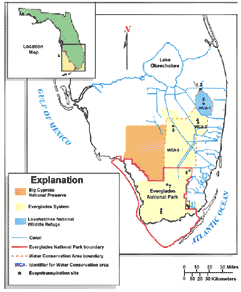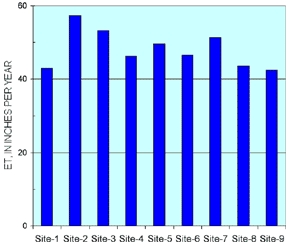Regional Evaluation of Evapotranspiration in the Everglades
Nine sites in the Florida Everglades were selected and instrumented for collection of data necessary for evapotranspiration (ET) determination using the Bowen ratio energy budget method. The sites were selected to represent sawgrass or cattail marshes, wet prairie, and open-water areas that comprise most of the natural Everglades system. The study area and site locations are shown in figure 1. Site characteristics are given in the following table.
| Site number | Community | Latitude-Longitude | Comments |
|---|---|---|---|
| 1 | Cattails | 263910 0802432 | Never dry |
| 2 | Open water | 263740 0802612 | Never dry |
| 3 | Open water | 263120 0802013 | Never dry |
| 4 | Dense sawgrass | 261900 0802307 | Dry part of most years |
| 5 | Medium sawgrass | 261541 0804356 | Dry part of some years |
| 6 | Medium sawgrass | 254450 0803007 | Never dry |
| 7 | Sparse sawgrass | 253655 0804211 | Never dry |
| 8 | Sparse rushes | 252112 0803807 | Dry part of every year |
| 9 | Sparse sawgrass | 252135 0804600 | Dry part of every year |
At each site, measurements necessary for ET calculation and modeling were automatically made and stored on-site at 15- or 30-minute intervals. Data collected included air
temperature, humidity, wind speed and direction, incoming solar radiation, net solar radiation, water level and temperature, soil moisture content, soil temperature, soil heat flux, and rainfall. Data are available for eight of the nine sites for January 1996 through December 1997, and for one site January-December 1997. Four sites were continued through September 1999 and two sites were still being operated in September 2000. Four additional sites were installed in November 2000 in Shark Valley Slough to provide ET and meteorological data for development of hydrologic models, and to confirm regional models of ET developed using data from the original network of 9 ET sites.

Figure 1. The Everglades and locations of evapotranspiration (ET) stations. Click for larger image.
Modified Priestley-Taylor models of latent heat (ET) as a function of selected independent variables were developed at each of the nine sites, using data for January 1996 through December 1997, when all nine sites were operated. The Priestley Taylor model was selected because it provided a good fit at all sites, and requires less information than other ET models. The site models were used to fill in periods of missing latent-heat measurement. The individual site models were combined and used to formulate regional models of ET that may be used to estimate ET in wet prairie, sawgrass or cattail marsh, and open-water portions of the natural Everglades system. The models are not applicable to forested areas or to the brackish areas adjacent to Florida Bay.
Two types of regional models were developed. One type of model uses measurements of the energy budget at a site, together with incoming solar energy and water depth, to estimate ET for 30-minute intervals. This energy-based model requires site data for net radiation, water heat storage, and soil heat flux, as well as data for incoming solar radiation and water depth. A second type of model was developed that does not require site energy-budget data and uses only incoming solar energy, air temperature, and water depth data to provide estimates of ET at 30-minute intervals. The second model thus uses data that are more readily available than the data required for the available-energy model, but does not give as precise an estimate of ET as the model using energy-budget measurements.
Precision of the site models and the regional models was evaluated for each site, and median model standard errors for the nine sites are shown in figure 2. Precision of theindividual site models is only slightly better than the regional model based on energy-budget measurement. The difference in precision of the two types of regional models is most noticeable for 30-minute ET totals. For 30-minute ET totals, the energy-based model has a standard error of about 32 percent and the non-energy-based model has a standard error of about 58 percent. For monthly ET totals, both types of models are much more precise, and have standard errors of about 7 percent for the energy-based model and about 9 percent for the non-energy-based model.

Figure 2. Median standard error for site and regional ET models. Click for larger image.
Computed ET mean annual totals for all nine sites for the 1996-97 period (fig. 3) range from 42.4 inches per year at site 9, where the water level is below land surface for several months each year to 57.4 inches per year at site 2, an open-water site with no emergent vegetation. The variation in ET follows a seasonal pattern, with lowest monthly ET totals occurring in December through February, and highest ET occurring in May through August. The monthly total ET among all nine sites for the 2-year period ranged from 1.81 inches in December 1997 to 6.84 inches in July 1996.

Figure 3. Mean annual ET for 1996-97. Click for larger image.
There is an inverse relation between ET and water level. This inverse relation applies whether the water level is above land surface or below land surface.
(This abstract was taken from the Greater Everglades Ecosystem Restoration (GEER) Open File Report (PDF, 8.7 MB))
Note: PDF files require the Adobe Acrobat Reader to be read. Download the FREE Adobe Acrobat Reader ®.
This page is: http://snowball /projects/evapotrans/regevalabgeer00.html
Comments and suggestions? Contact: Heather Henkel - Webmaster
Last updated: 11 October, 2002 @ 09:29 PM (KP)
